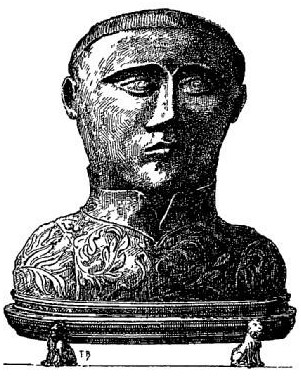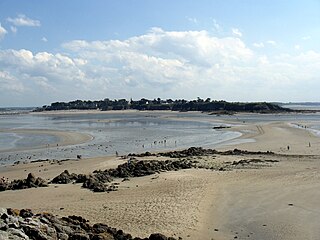
Gwen Teirbron was a Breton holy woman and wife of Fragan who supposedly lived in the 5th or 6th century. Her epithet is Welsh for '(of the) three breasts'.
Salomon was a late 5th century Cornish 'warrior prince', possibly a King of Cornwall. His feast day takes place on the 18 October. He was the father of the Cornish bishop Saint Cybi.

Conan Meriadoc is a legendary British Celtic leader credited with founding Brittany. Versions of his story circulated in both Brittany and Great Britain from at least the early 12th century, and supplanted earlier legends of Brittany's foundation. His story is known in two major versions, which appear in the Welsh text known as The Dream of Macsen Wledig, and in Geoffrey of Monmouth's Historia Regum Britanniae. Both texts associate him with Magnus Maximus, a Roman usurper against the Valentinianic dynasty who was widely regarded as having deprived Britain of its defences when he took its legions to claim the imperial throne. Conan's cousin or sister, Saint Elen, is said to have been Macsen Wledic's wife.

Winwaloe was the founder and first abbot of Landévennec Abbey, also known as the Monastery of Winwaloe. It was just south of Brest in Brittany, now part of France.

Budoc of Dol was a 5th-century Breton monk and Bishop of Dol, who has been venerated since his death as a saint in both Brittany and Devon. Budoc is the patron saint of Plourin in Finistère where his relics are preserved. His feast day was originally celebrated on 8 December, the date still used in Devon, but in Brittany this has been transferred to 9 December.

Gwened, Bro-Gwened or Vannetais is a historic realm and county of Brittany in France. It is considered part of Lower Brittany.

Saint-Jacut-de-la-Mer is a commune in the Côtes-d'Armor département of Brittany in northwestern France.

Saint Gwenhael was a Breton saint of the 6th century, born at Ergué-Gabéric (Finistère), the second abbot of Landévennec Abbey, successor in 532 to the founder, Saint Winwaloe (Gwenole). The feast of Saint Gwenaël is 3 November.
Cadfan, sometimes Anglicized as Gideon, was the 6th century founder-abbot of Tywyn and Bardsey, both in Gwynedd, Wales. He was said to have received the island of Bardsey from Einion Frenin, king of Llŷn, around 516 and to have served as its abbot until 542.

Saint Teilo, also known by his Cornish name Eliud, was a British Christian monk, bishop, and founder of monasteries and churches. He was from Penalun (Penally) near Tenby in Pembrokeshire, south Wales.
Creirwy is a figure in the Mabinogion and the Hanes Taliesin, daughter of the enchantress Ceridwen and Tegid Foel. The Welsh Triads name her one of the three most beautiful maids of the Isle of Britain. Born in Penllyn in Powys, Wales, Creirwy has a dark, hideous brother named Morfran and a foster brother, Gwion Bach. She does not appear in the stories about Afagddu and Taliesin.
Budic II, formerly known as Budick, was a king of Cornouaille in Brittany in the late 5th and early 6th centuries. He was father of Hoel as well as several Celtic saints.
Wethenoc or Gwethenoc or Guethenoc was a 5th-century pre-congregational Breton saint.
Jacut was a 5th-century Cornish Saint who worked in Brittany. He is commemorated liturgically on 6 February.

Saint Einion Frenin was a late 5th and early 6th century Welsh confessor and saint of the Celtic Church. His feast day was originally given as 9 February, although this had moved to the 10th or 12th by the 16th century and is no longer observed by either the Anglican or Catholic church in Wales.
Tewdwr Mawr was an early medieval king in Armorica and Cornwall.
Cynyr Ceinfarfog was a ruler of the Kingdom of Dyfed in Wales. He was known as Cunoricus in Latin and in English as Kendrick or as Cynyr the Red.
Fragan was a 5th-century pre-Congregational saint and Prince of Scotland. He is celebrated on 3 October in the Calendar of the Breton Saints, and shares with Gwen a feast day on 5 July in the Roman Calendar.
Saint Tydecho was a 6th century saint of Wales.









